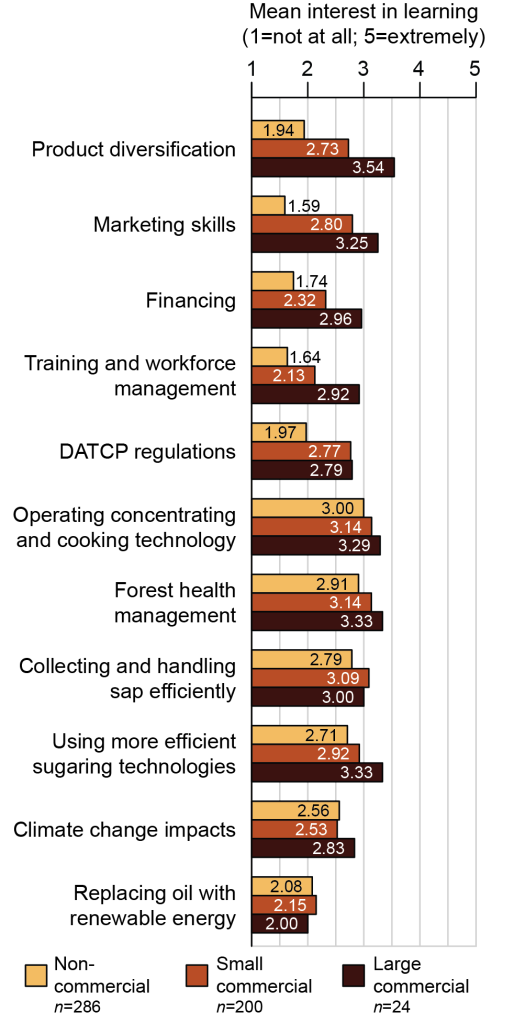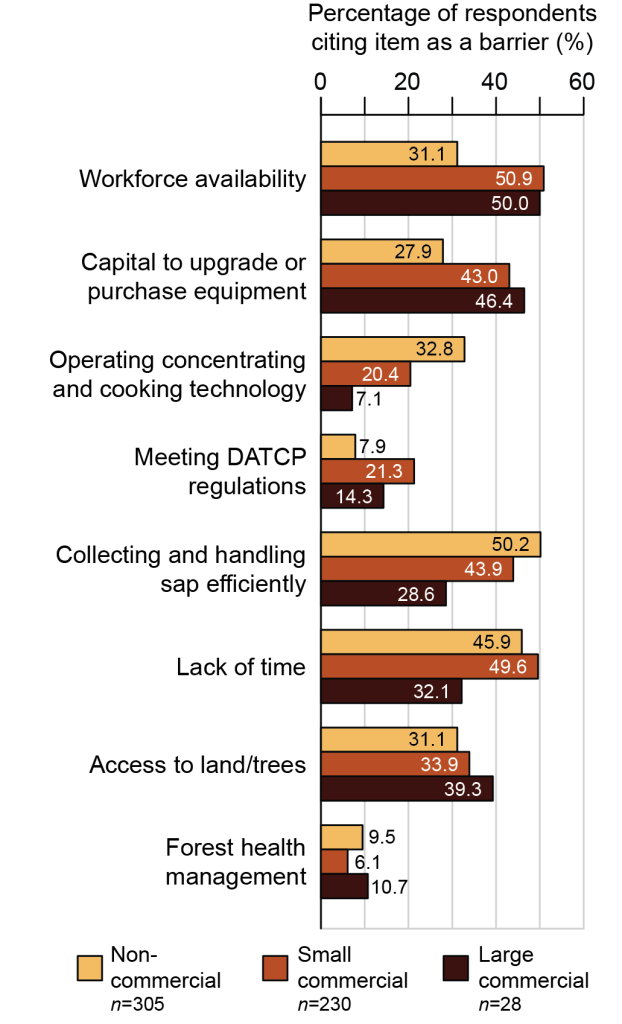Here at the Wisconsin Extension Maple Syrup Program, we’ve been combing through the results of our 2022 statewide survey of maple producers in order to offer programming relevant and useful to you. Thank you to everyone who participated—we received responses from 374 non-commercial producers, 255 small commercial producers, and 28 large commercial producers. For one part of the survey analysis, we compared the similarities and differences between these three groups. We wanted to better understand your current operations, motivations, learning interests, and barriers. Here’s a summary of what we found.
Characteristics of Wisconsin Sugarmaking Operations
Wisconsin has substantial contingents of both new and experienced non-commercial producers, while small commercial producers tend to have at least 6 seasons of experience. Most large producers have sugared for more than a decade. First-generation sugarmakers account for the majority of non-commercial and small commercial producers; nearly half of large commercial producers are third-generation sugarmakers. The table below shows more details about the Wisconsin sugarmaking community, including the various equipment that folks use. (Click the (+) to expand.)
Table: characteristics of operations surveyed
| Percentage of non-commercial producers | Percentage of small commercial producers | Percentage of large commercial producers | |
|---|---|---|---|
| Number of tapsa | |||
| None | 1.4 | 0 | 3.6 |
| <100 | 73.3 | 18.8 | 0 |
| 101-1000 | 24.6 | 60.4 | 3.6 |
| 1001-3500 | 0.8 | 14.9 | 21.4 |
| >3500 | 0 | 5.9 | 71.4 |
| Total | 100 (n=374) | 100 (n=255) | 100 (n=28) |
| Seasons of experiencea | |||
| 1-2 | 17.9 | 5.9 | 0 |
| 3-5 | 26.2 | 16.1 | 3.6 |
| 6-10 | 24.6 | 22.0 | 10.7 |
| >10 | 31.3 | 56.1 | 85.7 |
| Total | 100 (n=374) | 100 (n=255) | 100 (n=28) |
| Generation of sugarmaker in familya | |||
| 1st | 69.8 | 53.9 | 21.4 |
| 2nd | 19.3 | 21.3 | 17.9 |
| 3rd | 8.3 | 16.9 | 46.4 |
| 4th | 1.3 | 6.3 | 7.1 |
| 5th + | 1.3 | 1.6 | 7.1 |
| Total | 100 (n=374) | 100 (n=254) | 100 (n=28) |
| Sap collection equipmentb | |||
| Sacks/bags | 59.7 | 49.6 | 17.9 |
| Buckets | 47.6 | 39.6 | 3.6 |
| Gravity tubing | 23.5 | 27.4 | 14.3 |
| Vacuum (<18” Hg) | 3.5 | 15.2 | 21.4 |
| Vacuum (>18” Hg) | 1.9 | 19.1 | 75 |
| Sample size | n=315 | n=230 | n=28 |
| Sap processing equipmentb | |||
| Reverse osmosis | 19.6 | 51.8 | 81.5 |
| UV sanitizer | 3.9 | 3.5 | 3.7 |
| Filter press | 12.5 | 46.0 | 88.9 |
| Hydrometer | 59.5 | 82.3 | 77.8 |
| Auto draw-off | 3.2 | 32.3 | 77.8 |
| Pre-heater | 27.3 | 40.3 | 66.7 |
| Air injection | 2.9 | 7.1 | 18.6 |
| Evaporator | 46.6 | 69.5 | 85.2 |
| Flat pan | 60.8 | 38.1 | 7.4 |
| Sample size | n=311 | n=226 | n=27 |
| Primary fuel for boiling sapa | |||
| Wood | 76.0 | 82.1 | 33.3 |
| Gas | 16.6 | 4.0 | 22.2 |
| Oil | 2.6 | 10.8 | 33.3 |
| Other | 4.8 | 3.1 | 11.1 |
| Total | 100 (n=313) | 100 (n=223) | 100 (n=27) |
aRespondents had to select just one answer choice. Column sums may differ slightly from 100% due to rounding.
bRespondents answered a multiple-select question to indicate all the equipment that they use, so columns do not sum to 100%.
Motivations for Making Maple Syrup
A love of spending time in nature unifies Wisconsin sugarmakers—over 70% of producers in all three categories said that nature is a strong motivation for engaging in sugarmaking. For large commercial producers, finances tend to be the second-greatest motivation, while for the other two groups, finances are unsurprisingly the least important motivation. Family, culture, and physicality are strong motivators for some sugarmakers and unimportant for others, with no clear differences between the three producer categories.
Learning Interests
We asked about your levels of interest in learning about a wide range of sugarmaking topics (see figure). Among large commercial producers, product diversification emerged as the top interest. Non-commercial and small commercial producers, by contrast, are most interested in learning about operating concentrating and cooking technology and forest health management.
Producers in all three groups tended to express medium levels of interest in learning about sugarbush management. For all three groups, the top three sugarbush management topics are:
- Unwanted insects and diseases
- Invasive plants
- Sustainable silvicultural management.
Road construction and maintenance is the lowest-ranking learning interest.
Desire to Expand and Barriers to Expansion
As we seek to support Wisconsin’s maple industry, we wanted to know whether producers intend to expand their operations. We found that on average, non-commercial producers have a medium desire to expand (3 on a 5-point scale), small commercial producers have a somewhat stronger desire (3.5), and large commercial producers tend to be even more enthusiastic about expanding (4.2).
When we dug deeper into the data, we found that the sugarmakers with a higher desire to expand tend to be those who are more motivated by finances, have fewer seasons of sugarmaking experience, or are newer landowners.
But expanding your operation requires more than just enthusiasm—it involves overcoming barriers. We found four key barriers to expansion that sugarmakers face, depending on your type of operation (see figure).
- Collecting and handling sap efficiently and a lack of time are each a barrier for around half of non-commercial and small commercial producers.
- Workforce availability and a lack of capital for equipment are each a barrier for around half of both small and large commercial producers.
Next Steps
So far, we’ve shared our findings at a poster session at the Wisconsin State Capitol and at a meeting of the Wisconsin Maple Syrup Producers Association. We’re working on publishing a series of papers in academic journals to share our results and recommendations with foresters and educators who engage with maple syrup producers. One paper will be published soon, and another is already available as a preprint (not yet peer-reviewed). Two graduate students at UW–Madison, Chen-Ting Chang and myself (Scott Hershberger), have led the data analysis and writing of those papers. Chen-Ting is a PhD student in the Department of Communication Arts, and I am an MS student in the Department of Life Sciences Communication.
Most importantly, our team will be developing future Wisconsin Extension Maple Syrup Program events and resources to cover your top learning interests and help you address the barriers that you face. Our next event is the July Maple Hour, continuing our monthly webinar series. Join us at noon on Wednesday, July 26 to learn about sugarbush forest health. We’ll be joined by Paul Cigan, a Forest Health Specialist at the Wisconsin DNR, to discuss some common pests and diseases that can impact your sugarbush. We invite you to bring questions about what you’ve been seeing in your woods.
Update, December 12, 2023: The three papers mentioned above have all now been published:
- Chang, C.-T., Shaw, B. R., Solin, J., Gorby, T. A., & Robinson, P. (2023). Influence of Forester Traits and Advising Approaches on Landowners’ Intention to Follow Recommendations About Maple Sugarbush Management among Sap Producers in Wisconsin. Journal of Forestry, 121(5–6):408–418. https://doi.org/10.1093/jofore/fvad027
- Chang, C.-T., Gorby, T. A., Shaw, B. R., Solin, J., Robinson, P., Tiles, K., & Cook, C. (2023). Influence of learner characteristics on optimal knowledge acquisition among Wisconsin maple syrup producers. The Journal of Agricultural Education and Extension. Advance online publication. https://doi.org/10.1080/1389224X.2023.2254286
- Hershberger, S., Shaw, B., Gorby, T. A., Solin, J., Robinson, P., Tiles, K., Cook, C., & Chang, C.-T. (2023). Comparing Motivations, Learning Interests, and Barriers to Expansion Among Non-commercial and Commercial Maple Syrup Producers in Wisconsin. Small-scale Forestry. Advance online publication. https://doi.org/10.1007/s11842-023-09557-9 (free PDF at https://rdcu.be/dsm19)







